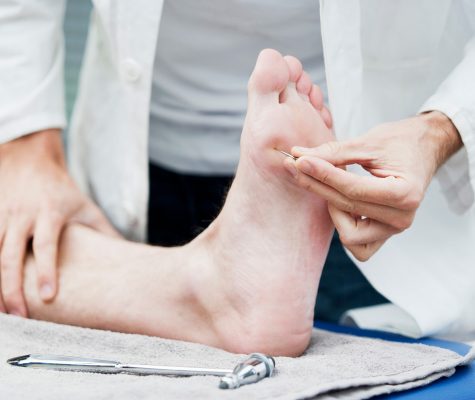What is Neuropathy?
Of the 16 million Americans with diabetes, 25% develop foot problems related to the disease. This is primarily due to a condition called neuropathy. Diabetic Neuropathy is a complication of diabetes that affects the nerves. The most common type of diabetic neuropathy is called peripheral neuropathy and affects the peripheral nerves. Peripheral nerves are the nerves that go out from the brain and spinal cord to the muscles, skin, internal organs, and glands. Peripheral neuropathy impairs the proper functioning of these sensory and motor nerves.
The most common symptoms of neuropathy include numbness and loss of feeling, usually in the feet and hands.

What is Neuropathy?
Of the 16 million Americans with diabetes, 25% develop foot problems related to the disease. This is primarily due to a condition called neuropathy. Diabetic Neuropathy is a complication of diabetes that affects the nerves. The most common type of diabetic neuropathy is called peripheral neuropathy and affects the peripheral nerves. Peripheral nerves are the nerves that go out from the brain and spinal cord to the muscles, skin, internal organs, and glands. Peripheral neuropathy impairs the proper functioning of these sensory and motor nerves.
The most common symptoms of neuropathy include numbness and loss of feeling, usually in the feet and hands.


Cause
Diabetic Neuropathy can cause insensitivity or a loss of ability to feel pain, heat, and cold. Diabetics suffering from neuropathy can develop minor cuts, scrapes, blisters, or pressure sores that they may not be aware of due to the insensitivity. If these minor injuries are left untreated, complications may result and lead to ulceration and possibly even amputation. Neuropathy can also cause deformities such as Bunions, Hammer Toes, and Charcot Feet.
It is imperative for people with diabetes to take the necessary precautions to prevent all foot-related injuries. Due to the consequences of neuropathy, daily observation of the feet is critical. When a diabetic patient takes the necessary preventative footcare measures, he or she reduces the risk of developing serious foot conditions.
Cause
Diabetic Neuropathy can cause insensitivity or a loss of ability to feel pain, heat, and cold. Diabetics suffering from neuropathy can develop minor cuts, scrapes, blisters, or pressure sores that they may not be aware of due to the insensitivity. If these minor injuries are left untreated, complications may result and lead to ulceration and possibly even amputation. Neuropathy can also cause deformities such as Bunions, Hammer Toes, and Charcot Feet.
It is imperative for people with diabetes to take the necessary precautions to prevent all foot-related injuries. Due to the consequences of neuropathy, daily observation of the feet is critical. When a diabetic patient takes the necessary preventative footcare measures, he or she reduces the risk of developing serious foot conditions.

Treatment and Prevention
The most successful way to prevent diabetic neuropathy from occurring is to control diabetes. It is important to maintain blood sugars at normal levels and maintain normal blood pressure. In addition to this, it is important to:
- Stop Smoking
- Limit the amount of alcohol you drink
- Have regular physical exams
- Have regular blood and urine tests
- Exercise regularly, according to your doctor’s recommendation
It is important for diabetics to treat their feet properly to avoid any future problems. Footwear and foot orthotics play an important role in diabetic footcare. Footwear that fits poorly can cause irritation and injury. Orthotics designed with Plastazote®, the #1 material for protecting the insensitive diabetic foot, are also frequently recommended. Plastazote is a material designed to accommodate pressure “hot spots” by conforming to heat and pressure. By customizing to the foot, Plastazote provides the comfort and protection needed in diabetic footcare. Footwear constructed with Plastazote is often recommended for the diabetic patient.
Diabetic footwear should also provide the following benefits:
- High, wide toe box (high and wide space in the toe area)
- Removable insoles for fitting flexibility and the option to insert orthotics if necessary.
- Rocker soles, designed to reduce pressure in the areas of the foot most susceptible to pain, most notably the heel and the ball-of-the-foot.
- Firm Heel Counters for extra and support and stability.
It is important for people with diabetes with neuropathy to take the necessary precautions to prevent injury and keep their feet healthy. If you have diabetes and are experiencing a foot problem, immediately consult with your foot doctor.
Your podiatric physician/surgeon has been trained specifically and extensively in the diagnosis and treatment of all manners of foot conditions. This training encompasses all of the intricately related systems and structures of the foot and lower leg including neurological, circulatory, skin, and the musculoskeletal system, which includes bones, joints, ligaments, tendons, muscles, and nerves.
Treatment and Prevention
The most successful way to prevent diabetic neuropathy from occurring is to control diabetes. It is important to maintain blood sugars at normal levels and maintain normal blood pressure. In addition to this, it is important to:
- Stop Smoking
- Limit the amount of alcohol you drink
- Have regular physical exams
- Have regular blood and urine tests
- Exercise regularly, according to your doctor’s recommendation
It is important for diabetics to treat their feet properly to avoid any future problems. Footwear and foot orthotics play an important role in diabetic footcare. Footwear that fits poorly can cause irritation and injury. Orthotics designed with Plastazote®, the #1 material for protecting the insensitive diabetic foot, are also frequently recommended. Plastazote is a material designed to accommodate pressure “hot spots” by conforming to heat and pressure. By customizing to the foot, Plastazote provides the comfort and protection needed in diabetic footcare. Footwear constructed with Plastazote is often recommended for the diabetic patient.
Diabetic footwear should also provide the following benefits:
- High, wide toe box (high and wide space in the toe area)
- Removable insoles for fitting flexibility and the option to insert orthotics if necessary.
- Rocker soles, designed to reduce pressure in the areas of the foot most susceptible to pain, most notably the heel and the ball-of-the-foot.
- Firm Heel Counters for extra and support and stability.
It is important for people with diabetes with neuropathy to take the necessary precautions to prevent injury and keep their feet healthy. If you have diabetes and are experiencing a foot problem, immediately consult with your foot doctor.
Your podiatric physician/surgeon has been trained specifically and extensively in the diagnosis and treatment of all manners of foot conditions. This training encompasses all of the intricately related systems and structures of the foot and lower leg including neurological, circulatory, skin, and the musculoskeletal system, which includes bones, joints, ligaments, tendons, muscles, and nerves.
